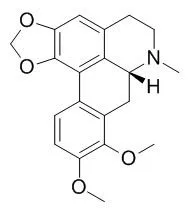| Description: |
Crebanine has antiarrhythmic, anticancer, anti-inflammatory,
and analgesic properties; it can significantly improve the cognitive deficits induced by scopolamine, via the alpha-7 nicotinic acetylcholine receptor, crebanine or its scaffold can be used as the starting point to develop a drug for Alzheimer's disease.Crebanine can reduce TNF-α-induced cancer cell proliferation, invasion, and survival by suppressing NF-κB activity and expression profile of its downstream genes. |
| In vitro: |
| Chem Pharm Bull (Tokyo). 2012;60(10):1283-9. | | Induction of G1 arrest and apoptosis in human cancer cells by crebanine, an alkaloid from Stephania venosa.[Pubmed: 22863844] | In this study, we focused the effects of Crebanine, an alkaloid isolated from the tuber of Stephania venosa, on various human cancer cells.
METHODS AND RESULTS:
Crebanine treatment was found to significantly inhibit the proliferation of human leukemic cells (HL-60, U937 and K562), human fibrosarcoma cells (HT1080) and cervix cancer cell lines (KB-3-1 and KB-V1), of which HL-60 cells were the most sensitive to its treatment. In contrast, Crebanine caused much less toxicity in human normal fibroblast cells. Our results demonstrated that Crebanine mediated cell cycle arrest at G0/G1 phase and this was associated with down-regulation of cyclins A and D. In addition, Crebanine induced apoptosis, which was detected by observation of the membrane phospholipid exposure in flow cytometry. Its induction of apoptosis was accompanied by an increase in cleavage of caspase-3, -8, -9 and poly(ADP-ribose) polymerase (PARP), and was attributable to the augmentation of Bax/Bcl proteins level. Crebanine also decreased mitochondrial membrane potential.
CONCLUSIONS:
Taken together, Crebanine exerts anti-proliferative effects on human cancer cells through the induction of cell cycle arrest at the G1 phases and apoptosis. Our results suggest that Crebanine is a promising new candidate as a chemotherapeutic agent for cancer therapy. | | Chem Pharm Bull (Tokyo). 2013;61(11):1156-65. | | Anti-invasion effect of crebanine and O-methylbulbocapnine from Stephania venosa via down-regulated matrix metalloproteinases and urokinase plasminogen activator.[Pubmed: 23985774] |
METHODS AND RESULTS:
We investigated the anti-invasive properties of four alkaloids from S. venosa, Crebanine (CN), O-methylbulbocapnine (OMBC), tetrahydropalmatine (THP), and N-methyltetrahydropalmatine (NMTHP), in HT1080 human fibrosacroma cells. Treatment of the cells with 15 μg/mL of Crebanine and OMBC reduced the chemo-invasion of HT1080 cells to 45 and 50%, respectively, whereas THP and NMTHP had a negative effect. On the other hand, Crebanine and OMBC had no effect on cell migration. Matrix metalloproteinases (MMPs) and urokinase plasminogen activator (uPA) are the extracellular matrix (ECM) degradation enzymes that play an important role in cancer cell metastasis. Results from zymography and western blot analysis showed that Crebanine and OMBC comparatively reduced MMP-2, MMP-9, MT1-MMP and uPA expression in a dose-dependent manner. However, Crebanine and OMBC had no effect on the activity of collagenase, MMP-2 and MMP-9. We also found that Crebanine and OMBC reduced the nuclear translocation and DNA binding activity of nuclear factor kappa B (NF-κB), which is the expressed mediator of ECM degradation enzymes.
CONCLUSIONS:
These findings demonstrated that Crebanine and OMBC mediated HT1080 cell invasion by the reduction of MMP-2, MMP-9, uPA and MT1-MMP expression, possibly by targeting of NF-κB signaling pathway in the HT1080 cells. | | Biol Pharm Bull. 2016;39(1):54-61. | | Antiinflammatory Activities of Crebanine by Inhibition of NF-κB and AP-1 Activation through Suppressing MAPKs and Akt Signaling in LPS-Induced RAW264.7 Macrophages.[Pubmed: 26499331 ] | Crebanine, an aporphine alkaloid, displays various biological activities such as anticancer and antimicrobial activities.
METHODS AND RESULTS:
In this study, we further investigated the suppressive effect of Crebanine on lipopolysaccharide (LPS)-induced expression of proinflammatory mediators and the molecular mechanisms underlying these activities in RAW264.7 macrophages. Crebanine inhibited the production of proinflammatory cytokines including interleukin-6 (IL-6) and tumor necrosis factor-alpha in LPS-induced RAW264.7 cells. Moreover, Crebanine suppressed LPS-induced inducible nitric oxide (iNO) and prostaglandin E2 and reduced the expression of iNO synthase and cyclooxygenase-2 in RAW264.7 cells. Crebanine suppressed LPS-induced phosphorylation of Akt and mitogen-activated protein kinases (MAPKs), including extracellular signaling-regulated kinase 1/2, c-Jun NH2-terminal kinase, and p38 MAPK signaling. In addition, the specific inhibitor of MAPKs and Akt reduced the expression of IL-6 and NO production in LPS-induced macrophages. Furthermore, Crebanine inhibited LPS-induced nuclear factor kappa B (NF-κB) activation by reducing the phosphorylation of p65 at Ser536 but not the p65 translocation to the nucleus and inhibitory factor kappa B alpha degradation. Crebanine also suppressed phosphorylation and nucleus translocation of activator protein-1 (AP-1).
CONCLUSIONS:
These observations suggest that the antiinflammatory properties of Crebanine may stem from the inhibition of proinflammatory mediators via suppression of the NF-κB, AP-1, MAPKs, and Akt signaling pathways. |
|






 Cell. 2018 Jan 11;172(1-2):249-261.e12. doi: 10.1016/j.cell.2017.12.019.IF=36.216(2019)
Cell. 2018 Jan 11;172(1-2):249-261.e12. doi: 10.1016/j.cell.2017.12.019.IF=36.216(2019) Cell Metab. 2020 Mar 3;31(3):534-548.e5. doi: 10.1016/j.cmet.2020.01.002.IF=22.415(2019)
Cell Metab. 2020 Mar 3;31(3):534-548.e5. doi: 10.1016/j.cmet.2020.01.002.IF=22.415(2019) Mol Cell. 2017 Nov 16;68(4):673-685.e6. doi: 10.1016/j.molcel.2017.10.022.IF=14.548(2019)
Mol Cell. 2017 Nov 16;68(4):673-685.e6. doi: 10.1016/j.molcel.2017.10.022.IF=14.548(2019)